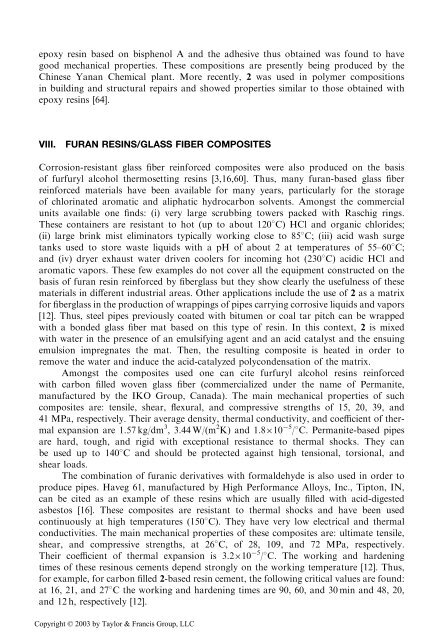30. Furan-Based Adhesives
30. Furan-Based Adhesives
30. Furan-Based Adhesives
Create successful ePaper yourself
Turn your PDF publications into a flip-book with our unique Google optimized e-Paper software.
epoxy resin based on bisphenol A and the adhesive thus obtained was found to have<br />
good mechanical properties. These compositions are presently being produced by the<br />
Chinese Yanan Chemical plant. More recently, 2 was used in polymer compositions<br />
in building and structural repairs and showed properties similar to those obtained with<br />
epoxy resins [64].<br />
VIII. FURAN RESINS/GLASS FIBER COMPOSITES<br />
Corrosion-resistant glass fiber reinforced composites were also produced on the basis<br />
of furfuryl alcohol thermosetting resins [3,16,60]. Thus, many furan-based glass fiber<br />
reinforced materials have been available for many years, particularly for the storage<br />
of chlorinated aromatic and aliphatic hydrocarbon solvents. Amongst the commercial<br />
units available one finds: (i) very large scrubbing towers packed with Raschig rings.<br />
These containers are resistant to hot (up to about 120 C) HCl and organic chlorides;<br />
(ii) large brink mist eliminators typically working close to 85 C; (iii) acid wash surge<br />
tanks used to store waste liquids with a pH of about 2 at temperatures of 55–60 C;<br />
and (iv) dryer exhaust water driven coolers for incoming hot (230 C) acidic HCl and<br />
aromatic vapors. These few examples do not cover all the equipment constructed on the<br />
basis of furan resin reinforced by fiberglass but they show clearly the usefulness of these<br />
materials in different industrial areas. Other applications include the use of 2 as a matrix<br />
for fiberglass in the production of wrappings of pipes carrying corrosive liquids and vapors<br />
[12]. Thus, steel pipes previously coated with bitumen or coal tar pitch can be wrapped<br />
with a bonded glass fiber mat based on this type of resin. In this context, 2 is mixed<br />
with water in the presence of an emulsifying agent and an acid catalyst and the ensuing<br />
emulsion impregnates the mat. Then, the resulting composite is heated in order to<br />
remove the water and induce the acid-catalyzed polycondensation of the matrix.<br />
Amongst the composites used one can cite furfuryl alcohol resins reinforced<br />
with carbon filled woven glass fiber (commercialized under the name of Permanite,<br />
manufactured by the IKO Group, Canada). The main mechanical properties of such<br />
composites are: tensile, shear, flexural, and compressive strengths of 15, 20, 39, and<br />
41 MPa, respectively. Their average density, thermal conductivity, and coefficient of thermal<br />
expansion are 1.57 kg/dm 3 , 3.44 W/(m 2 K) and 1.8 10 5 / C. Permanite-based pipes<br />
are hard, tough, and rigid with exceptional resistance to thermal shocks. They can<br />
be used up to 140 C and should be protected against high tensional, torsional, and<br />
shear loads.<br />
The combination of furanic derivatives with formaldehyde is also used in order to<br />
produce pipes. Haveg 61, manufactured by High Performance Alloys, Inc., Tipton, IN,<br />
can be cited as an example of these resins which are usually filled with acid-digested<br />
asbestos [16]. These composites are resistant to thermal shocks and have been used<br />
continuously at high temperatures (150 C). They have very low electrical and thermal<br />
conductivities. The main mechanical properties of these composites are: ultimate tensile,<br />
shear, and compressive strengths, at 26 C, of 28, 109, and 72 MPa, respectively.<br />
Their coefficient of thermal expansion is 3.2 10 5 / C. The working and hardening<br />
times of these resinous cements depend strongly on the working temperature [12]. Thus,<br />
for example, for carbon filled 2-based resin cement, the following critical values are found:<br />
at 16, 21, and 27 C the working and hardening times are 90, 60, and 30 min and 48, 20,<br />
and 12 h, respectively [12].<br />
Copyright © 2003 by Taylor & Francis Group, LLC
















